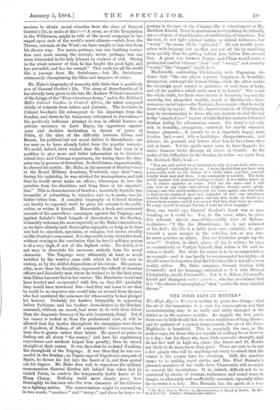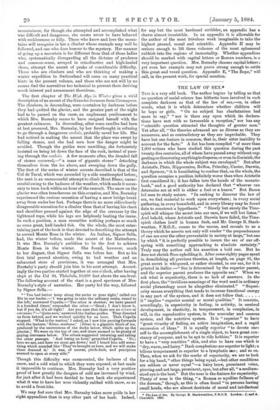THE HIGH ALPS IN WINTER.* The High Alps in Winter
is written to prove two things,—that the air of the'mountains is a cure for consumption, and that mountaineering may be as easily and safely managed in the winter as in the summer months. As regards the first point, there can be little doubt that for some conditions of lung disease, and for patients of a certain temperament, the air of the Swiss Highlands is beneficial. This is especially the case, as the author says, for those who are capable-of walking for an hour or so a day ; but for those who have little muscular strength, and do not feel well in high air, places like Davos and St. Moritz are likely to do more harm than good. There are sure to be not a few people who will be anything but ready to admit that the winter is the proper time for climbing. Still, the practice seems to be making rapid strides, and Mrs. Fred Burnaby's pleasant narrative of her walks from Chamounix will do much to convert the incredulous. It is, indeed, difficult not to be convinced by stories of courage, endurance, and sound sense in danger, so pleasantly and unaffectedly narrated, especially when the narrator is a lady. Mrs. Burnaby has the spirit of a true
The Sigh Alps in Winter ; or, Mountaineering in Search of Health. By Mrs- Fred Burnaby. London : Sampson Low and Co.
mountaineer, for though she attempted and accomplished what was difficult and dangerous, she seems never to have behaved with recklessness or folly. Those who know and love the moun- tains will recognise in her a climber whose example may well be followed, and one who does honour to the mystery. Her manner • of going up a mountain is far different from that of those ladies who, systematically disregarding all the dictates of prudence and common-sense, arrayed in crinolinettes and high-heeled shoes, attempt the ascent of peaks of considerable difficulty. Those who are climbers and who are thinking of making a
-winter expedition to Switzerland will come on many practical hints in the present volume, and those who are not will by no means find the narratives too technical to prevent them deriving much interest and amusement therefrom.
The first chapter of The High Alps in Winter gives a vivid description of an ascent of the Grandes Jorasses from Cormayeur. The climbers, in descending, were overtaken by darkness before they had quitted the glacier, and the greater part of the night had to be passed on the snow, an unpleasant predicament to which Mrs. Burnaby seems to have resigned herself with the greatest calmness. In descending, after some candles had been at last procured, Mrs. Burnaby, by her forethought in refusing to go through a dangerous couloir, probably saved her life. She had noticed in making the ascent that the place was swept by falling stones, and she had seen how the danger might be avoided. Though the guides were unwilling, she fortunately insisted on being let down the face of the rock, instead of pass- ing through the couloir. A few moments after, the dreaded fall of stones occurred,—" a mass of gigantic stones " detaching
themselves from the ice above, and sweeping down the gully. The first of the series of winter ascents described is that of the Col de Tacnl, which was ascended by a side unattempted before; -the next is an unsuccessful attempt to climb Mont Blanc, unsuc- cessful owing to the badness of the weather, which made it neces- sary to turn back within an hour of the summit. The snow on the glacier was often treacherous on this occasion, and Mrs. Burnaby experienced the curious sensation of having a snow bridge break away from under her feet. Perhaps there is no more ridiculously
• disagreeable sensation for a climber than that of having his chest and shoulders pressed against the edge of the crevasse by the tightened rope, while his legs are helplessly beating the inane. In such a position, a. man resembles nothing perhaps so much as some great, half-landed fish. On the whole, the most enter- taining part of the book is that devoted to describing the attempt to ascend Monte Rosa in the winter. An Italian, Signor Sella, had, the winter before, made the ascent of the Matterhorn.
It was Mrs. Burnaby's ambition to be the first to achieve Monte Rosa in the winter. She found, however, much to her disgust, that Signor Sella was before her. But as his first trial proved abortive, owing to bad weather and an 'exhausted store of provisions, it was arranged that Mrs. Burnaby's party should join him in his next attempt. Accord- ingly the two parties started together at one o'clock, after having slept at the Col St. Theodule, 10,899 feet above the sea-level. The following account of the start is a good specimen of Mrs- Burnaby's style of narration. Her party led the way, followed by Signor Sella :—
" You had better keep along the rocks to your right,' called out Bic to our leader.—' I was going to take the ordinary route, round to the left,' answered Cupelin.—' The other is shorter; we have passed it a hundred times,' responded the other.—' Good ; I don't know it, but if you do, it's all right! Are you sure that there are no seraex or crevasses ?'—‘ Quite sure,' answered the Italian guides. They directed us from behind, and we walked quickly for an hour. Then Cupelin stopped. What is the matter,' I asked, as I saw him peering forwards with the lantern, Serac. madame.' [Sera° is a gigantic block of ice, produced by the unevenness of the rocks below, which splits up the glacier.] We were on the top of one, and there seemed to be plenty of ;gaping crevasses below. The others suggested returning and taking
the other passage. And losing an hour,' grumbled Cupelin. No ; here we are, and here we must get down;' and I heard him add some- thing which sounded like ' They've brought us here, and we will make them descend it.' It was, of course, pitch-dark, and precipices seemed to open at every side."
Though this difficulty was surmounted, the badness of the snow, and a cold wind to which they were exposed; at last made it impossible to continue. Mrs. Burnaby had a very positive proof of how greatly the dangers of cold are increased by wind, for just after it bad been decided to turn back she experienced what it was to have her nose violently rubbed with snow, so as to avoid a frost-bite.
We may feel sure that Mrs. Burnaby takes more pride in her eight appendices than in any other part of her book. Indeed, for any but the most hardened scribbler, an appendix has a charm almost irresistible. In an appendix it is allowable for the author of the most frivolous work imaginable to take the highest ground, moral and scientific. Appendix H may be serious enough to lift three volumes of the most ephemeral rubbish into the regions of immortality. Whether appendices should be marked with capital letters or Roman numbers, is a very important question. Mrs. Burnaby chooses capital letters ; yet even her example may not prove strong enough to settle this great and vexed question. Appendix E, "The Rope," will call, in the present work, for special mention.







































 Previous page
Previous page